Categories: all aviation Building a Biplane bicycle gadgets misc motorcycle theater
Sat, 14 Jul 2007
I was dissappointed that the gas welding forum wasn't happening, so I wandered. The weather was doing strange things, but the rain had stopped (I got to use my new umbrella for both rain and sun that day), and heavy clouds were visually duking it out in the sky.
Finally, and surprisingly quickly, 1 pm rolled around, and it was time for another workshop. I had a choice between TIG welding and fabric covering, and I vacillated for a bit, but finally decided on fabric covering. I know that's something I'll be doing, and I was really curious how it's done, since no one really talks about the process itself.
The workshop was presented by Poly-Fiber, one of the manufacturers of fabric and related chemicals, so I started out a little skeptical. However, the presenter himself (Gary, maybe? let's go with Gary) almost immediately explained that all the fabric comes from one mill, and the only difference is which stamp the put on it. That was good to hear, and he established that he didn't sell anything himself, so at least Gary wasn't completely biased. He's actually an aircraft mechanic in Canada.
Anyway, he talked for a while about the old way of doing it (cotton and butyrate dope) and the new way of doing it (unshrunk polyester and heat). A major difference between the two is that the cotton fabric had to be sewn into the right shape, and slipped on the piece to be covered (imagine sewing a sock big enough to fit around a wing or fuselage!). The polyester, on the other hand, can be adhered to the piece with glue. Gary allowed that now, it's likely we have adhesive sufficiently strong to adhere cotton as well, but cotton still lacks compared to polyester.
The other big difference is that polyester shrinks with heat. You apply a 250° iron to it, and it shrinks 5%. Apply a 350° iron to it, and it shrinks another 5%. Apply a 400° iron to it, and it starts permanently relaxing (ie, unshrinking), and at 426° it melts. So, obviously temperature control is important.
Cotton, on the other hand, is shrunk with water and about 27 coats of dope, each coat requiring sanding before the next. It's a lot more work. Apparently you can also finish polyester with dope, but it's still a lot of coats and sanding.
Anyway, the cool part of this workshop is that it was hands-on. Gary had a half-dozen steel frames on tables, and each was set up with a piece of fabric and a little tub of glue. We introduced ourselves to our neighbors, and set up two to a frame. In short order, we had the frame half-covered, and it didn't take long before it was entirely covered. The guy I was working with, Jim, and I managed to get the fabric fairly taut to begin with, but by the time we had it glued on and shrunk to fit, it was really tight. We were very happy with how easy and effective the process was.
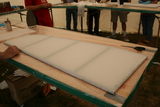
The panel Jim and I worked on |
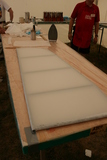
The panel Jim and I worked on |
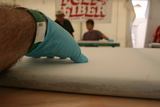
Pressing down with about 10-15 lbs of pressure |
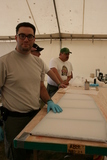
Ian, happy with his results |
The final task (as we listened to the airshow planes diving and twirling outside -- the workshop ran 30 minutes over time) was to remove the fabric for the next class. So, I pulled out my knife and slashed each section diagonally on one side, and we started pulling it off. The fabric was very difficult to rip, and only marginally easier to pull off the glue lines.
Most interestingly (I wish I'd gotten a picture of this), on the flip side, I'd just scored the fabric, without actually cutting through it. On the final panel, it was very lightly scored, and I tried punching through it. And again. And again. The scored line got wider, but it took 5 or 6 full-strength punches before it separated. That fabric is amazingly tough. Jim and I were both very impressed.
The final bit of presentation was on finishing the fabric. Interestingly, Gary said categorically that auto and house paint won't work because they'll crack from vibration. He also said that the scraps of fabric were souvenirs, so I grabbed a few, thinking I might do weathering tests with them.
It was funny, I could feel Gary's audience straining to go watch the airshow as he was standing there, explaining about paint, with the engine noises occasionally completely covering his voice. I'm surprised he ran over so far on time, since he'd done this same presentation at least 4-5 times already this week.
Getting out of the fabric workshop, I walked towards the airshow viewing area. There was (no surprise) an airplane flying around, trailing smoke. I guess I'm not very enthralled with airshow displays.
I realized at this point that I hadn't really eaten anything since 6:00 in the morning, so I walked back to the "food court" area (actually numerous carney-style booths selling corndogs and caramel apples). I was beginning to despair of finding food I might want to eat, when I spotted a place claiming to sell Mexican-style food such as quesadillas and soft tacos. I ordered a cheese quesadilla (yes, I know, redundant) after establishing that it wasn't made with that horrible plastic squirty cheese (I think I asked exactly that question: "Is the quesadilla made with that horrible plastic squirty cheese?" pointing at a display dish covered in flourescent orange goo). I also got a can of coke. Total bill? $7.50. Sheesh. Oh, but it included "salsa," which seemed to be ketchup with corn and black beans in it, and no spice whatsoever. It was acceptable as food, but definitely overpriced.
I watched the airplanes cavorting overhead, and chewed on my cheese-thing. It felt good to sit down, as this day entailed a lot of walking around.
I walked back and sat down to watch the airshow for a bit after lunch. It was impressive to watch the airplanes dancing around the sky, flying straight up for quite a distance before kicking the tail over. Perhaps most impressive about the displays is that the majority of the acrobatic planes were home-built.
The airshow concluded with a "military parade" which left me with mixed feelings -- my inner savage-child was screaming "Cool!" and the thinking upper layers were getting that sinking feeling of looking at instruments of death.
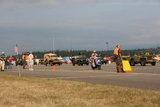
Military parade |
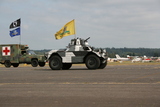
Light tank? |
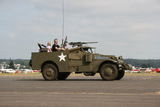
Yes, he's holding up a Tommy gun |

Ah, airplane, I like airplanes |
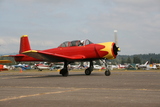
Mmm, radial engine |
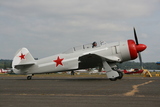
Wait, is that Russian? |
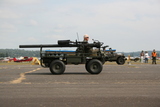
What is that thing? |
The late afternoon involved a lot of wandering around, looking for biplanes, but there just weren't many to be seen. I did find the acrobatic section, with a number of Christen Eagles painted in the distinctive color-burst scheme, which I really dislike.
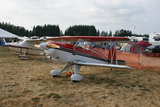
Acrobatic biplane |
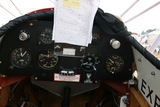
And its panel |
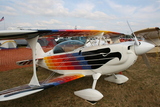
Christen Eagle |
Eventually, I found myself back at the Chapter 84 tent, talking with Tom about his plane. Specifically, I asked him about welding, which seems like it's going to be in my future. He suggested, in short, that I should start with gas welding. That's the conclusion I'd been coming to, but it was very nice to hear a real person say that. I find myself distrusting semi-anonymous Internet postings on what appear to be contentious topics. TIG vs. gas welding seems to be one of those topics.
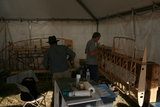
Tom, working on his Starduster Too wing, while Guy With Hat looks on |
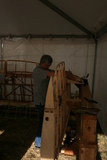
Tom working |
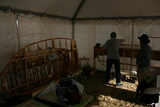
Guy With Hat looks on |
There was another person who was hanging around the 84 tent, who was one of those people who just talks and talks. As it happens, that's a habit that really gets on my nerves, so I was kind of annoyed to see he was still there -- he'd been there, talking at Tom before the fabric workshop as well. Still, I was very happy to have met Tom, and am looking forward to attending Chapter 84 meetings.
Finally, it was time to go. I'd been there since 7:30 in the morning, and it was now past 6, nearing 7. I walked towards the parking lot, and diverted when I realized that I'd never investigated the airplane rides being offered. I would kick myself if getting a ride in a biplane or a Beech 18 was available and I didn't even check it out.
I hit the Biplane Rides! booth, and saw that they were charging $60 per person. I asked a bit about the plane (some 1929 era plane I'd never heard of), and we established that $60 bought you 10-15 minutes in the air. I thought about it, and decided that was a waste of money -- I'm going to be getting plenty of biplane rides for $100+ per hour some time in the future if I proceed with this airplane project, so the $360/hr rate seemed a tad steep.
I did take the opportunity to take pictures of the plane, though. It was in excellent condition, and surprisingly had a four-place front cockpit: it'd been designed and built for taking people up on rides.
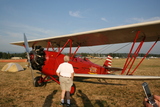
The ride-giving biplane |
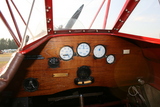
Now that's a simple panel |
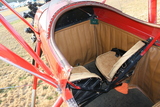
A front cockpit built for 4 |
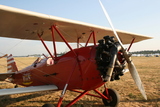
Dramatic sunset light |
Ok, really, time to head home. I walked back to the parking lot, going by way of the biplanes, when of course I noticed a new one. I went to look at it, and ended up following the pilot and a helper as they pushed it to its parking spot. It was a modified Acro Sport II (a plane which is, coincidentally, looking more attractive for my purposes), painted a very deep red, with black scallops on the wings. Pretty sharp looking. The pilot immediately took off, but said the builder would be by in five minutes. I waited a few minutes, but hunger and the desire to not be standing any more got the better of me. I walked back in the direction of the parking lot, stopping to take a few more pictures.
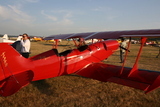
Modified Acro Sport II |
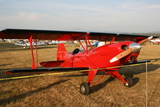
Modified Acro Sport II |
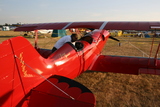
Modified Acro Sport II |
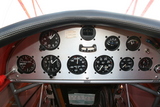
Modified Acro Sport II panel |
I was hailed at this point, "What are you going to do with all those pictures?" I walked over and started chatting with the guy (who was selling his Starduster Too for a mere $36k), and we ended up talking for about an hour. During that time another Starduster Too pulled in, and an extremely tall man climbed out. He explained that he'd gotten his tailwheel endorsement on July 4th, which means he had about 10 hours in a taildragger, if even that much. Daring, but I guess you gotta do what you gotta do when you buy a new plane.
I looked at my watch and realized it was almost 8 pm. I excused myself, and walked back to the sidecar rig. It was definitely time, as the sun sank below the trees. I had fun, but it was time to go home.
Posted at 11:34 permanent link category: /aviation
Categories: all aviation Building a Biplane bicycle gadgets misc motorcycle theater